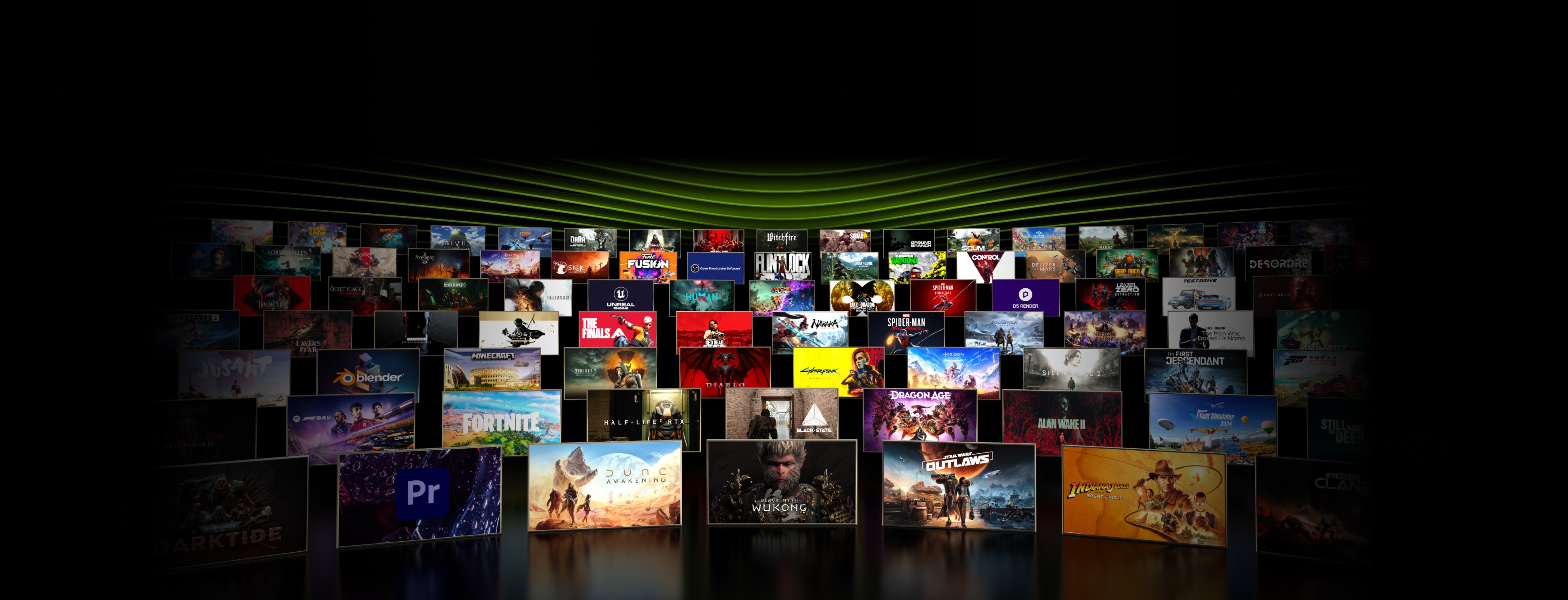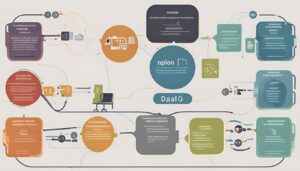The GPU landscape in 2025 has been reshaped by NVIDIA’s latest release: the GeForce RTX 50 Series, powered by the groundbreaking Blackwell architecture. This new lineup not only pushes the boundaries of gaming and AI performance but also sets a new benchmark for competitors like AMD and Intel. In this blog, we’ll dive deep into the features of the RTX 50 Series, compare it with its rivals, and explore what this means for the future of graphics technology.

The RTX 50 Series: A Technological Leap
Blackwell Architecture: The Heart of Innovation
The RTX 50 Series is built on NVIDIA’s Blackwell architecture, which boasts a staggering 92 billion transistors, making it the most powerful consumer GPU ever created. Key advancements include:
- Enhanced Tensor Cores: Support for FP4 precision models, enabling faster AI processing with reduced memory usage. This is a game-changer for AI-driven applications, from gaming to professional workloads.
- Next-Gen RT Cores: Ray tracing performance has doubled, allowing for unprecedented levels of detail in games and professional applications. This means more realistic lighting, shadows, and reflections in your favorite games.
- GDDR7 Memory: With speeds up to 30Gbps and bandwidth of 1.8TB/s, Blackwell GPUs deliver lightning-fast performance for both gaming and AI workloads. This ensures smoother gameplay and faster data processing.
DLSS 4 and AI-Driven Gaming
DLSS 4, NVIDIA’s latest upscaling technology, takes gaming to new heights. By leveraging AI, it enables smoother frame rates and higher resolutions, such as 8K at 120fps, while maintaining exceptional visual quality. This is a significant advantage over AMD’s FSR 3, which, while competitive, lacks the same level of AI integration.
For gamers, this means you can enjoy ultra-high-definition visuals without sacrificing performance. Whether you’re exploring vast open worlds or engaging in fast-paced multiplayer battles, DLSS 4 ensures a seamless experience.
Performance Across the Lineup
The RTX 50 Series offers a range of models to cater to different user needs:
- RTX 5090: The flagship model with 32GB GDDR7 memory, 512-bit bus width, and 1792 GB/s bandwidth. It delivers 3352 AI TOPS and 318 TFLOPS of ray tracing performance, making it a beast for 4K and 8K gaming.
- RTX 5080: A high-end option with 16GB GDDR7 memory and 1801 AI TOPS, priced at $999. This model is perfect for gamers who want top-tier performance without breaking the bank.
- RTX 5070: A mid-range powerhouse with 12GB GDDR7 memory and 988 AI TOPS, offering performance comparable to the RTX 4090 at a more accessible price point.
NVIDIA RTX 50 Series vs Competitors: A Detailed Comparison
AMD: Value vs. Performance
AMD’s RDNA 4 architecture, powering GPUs like the Radeon RX 8900 XT, focuses on value and energy efficiency. While it offers competitive rasterization performance and open-source technologies like FSR 3, it still lags behind NVIDIA in ray tracing and AI-driven features.
For example, in Cyberpunk 2077, the RTX 5090 achieves 125 FPS with DLSS 4, compared to the RX 8900 XT’s 110 FPS with FSR 3. This gap becomes even more pronounced in games that heavily rely on ray tracing, such as Alan Wake 2 or Control.
AMD’s strength lies in its affordability and energy efficiency, making it a solid choice for budget-conscious gamers. However, for those seeking the absolute best performance and cutting-edge features, NVIDIA remains the clear winner.
Intel: Playing Catch-Up
Intel’s Battlemage GPUs aim to compete in the mid-range market, but they face challenges in matching NVIDIA’s performance and feature set. Intel’s focus on improving driver performance and reducing power consumption is commendable, but it still has a long way to go to challenge NVIDIA’s dominance.
For instance, in benchmarks like Shadow of the Tomb Raider, Intel’s Battlemage GPUs struggle to keep up with NVIDIA’s RTX 5070, let alone the flagship RTX 5090. While Intel is making strides, it remains a third-place contender in the GPU race.
AI and Professional Workloads
NVIDIA’s CUDA cores and Tensor Cores give it a significant edge in AI and professional applications. For instance, the RTX 5090 outperforms AMD’s RX 8900 XT in tasks like Blender rendering and AI model training. This makes NVIDIA the preferred choice for professionals in fields like 3D modeling, video editing, and machine learning.
Moreover, NVIDIA’s ecosystem, including tools like CUDA and TensorRT, provides developers with the resources they need to optimize their applications for NVIDIA hardware. This level of integration is something AMD and Intel have yet to achieve.
Market Impact and Future Prospects
Pricing and Accessibility
NVIDIA has adopted a more consumer-friendly pricing strategy with the RTX 50 Series. The RTX 5070, for example, is priced at $549, making high-end performance more accessible. This move puts pressure on AMD and Intel to offer better value in their mid-range offerings.
By balancing performance and affordability, NVIDIA is appealing to a broader audience, from casual gamers to hardcore enthusiasts. This strategic pricing could help NVIDIA maintain its market dominance in the face of increasing competition.
The Rise of AI and Personal Computing
With innovations like Project DIGITS, NVIDIA is bringing AI supercomputing to the desktop. This compact device, powered by the GB10 Grace Blackwell chip, allows users to run complex AI models locally, reducing reliance on cloud infrastructure. This positions NVIDIA as a leader in the AI-driven future of computing.
For professionals and hobbyists alike, this means faster processing times and greater flexibility in AI development. Whether you’re training machine learning models or experimenting with generative AI, NVIDIA’s hardware provides the tools you need to succeed.
Challenges Ahead
Despite its advancements, NVIDIA faces challenges from competitors developing in-house GPUs and the growing demand for energy-efficient solutions. AMD’s focus on open-source technologies and Intel’s push for better power management could erode NVIDIA’s market share in the long run.
Additionally, as AI workloads become more prevalent, there’s a growing need for GPUs that balance performance with energy efficiency. NVIDIA will need to continue innovating to stay ahead of the curve.

Conclusion: NVIDIA’s Unrivaled Leadership
The RTX 50 Series cements NVIDIA’s position as the leader in GPU technology. With its unmatched performance, AI capabilities, and innovative features like DLSS 4, NVIDIA continues to set the standard for gaming and professional workloads. While AMD and Intel are making strides, they still have ground to cover in matching NVIDIA’s technological prowess.
For gamers, creators, and AI enthusiasts, the RTX 50 Series offers a glimpse into the future of computing—a future where performance, efficiency, and innovation converge to deliver unparalleled experiences.
















